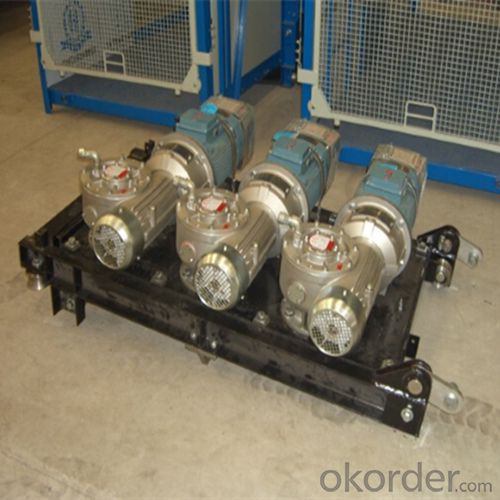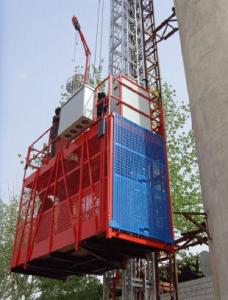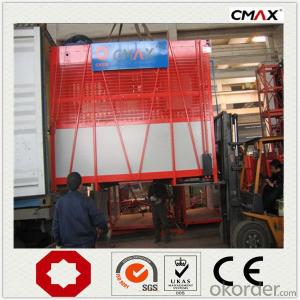Building Hoist SCD200 with Stepless Speed Control Helps Eliminate the Concussion
- Loading Port:
- China main port
- Payment Terms:
- TT or LC
- Min Order Qty:
- 1 unit
- Supply Capability:
- 30 unit/month
OKorder Service Pledge
OKorder Financial Service
You Might Also Like
Structure of Building Hoist Description
SC Hoist is a Rack and Pinion EL. Lift, used on construction site for transportation of personnel and materials. It is installed and dismounted conveniently and can grow as high as the buildings grow in height.
There are single cage and twin cage hoists. A single cage can be quickly transformed into twin cage hoist by adding a cage and other parts. The hoist payload can be increased by adding counterweight equipment.
SC Hoist has reliable electrical and mechanical safety device. It is a efficient and safety vertical transporting equipment.
Feature: Building Hoist Condition: New Application: Construction
Payload(kg):2000 Lifting Speed(m/min):0~60 Motor Power(kw): 2*15
Safety Device: SAJ40-1.4 Cage: Single Counterweight: Yes
Certification: CE,ISO Place of Origin: China(Mainland) Model Number: Type:SCD200
Packaging & Delivery of Building Hoist
Packaging Detail: Nude package Delivery Detail: 25-30days
Main Parts of Building Hoist
● Adopts the most advanced VF speed control device and microcomputer programmable logic controller.
● Stepless speed control helps eliminate the concussion during start up and braking, steady the operation process,
and ensures automated leveling.
● Adopts open loop V/Fcontrol; the speed control precision can reach ±2~3%. Realizes accurate low speed positioning of the hoist and avoid slipping during downward stopping of hoist.
● The VF system has current-restriction function, ensuring a small current when motor start up and reducing the concussion to power supply. It reduces the engery consumption and mitigates effects to on site electric equipments.
● The steadiness during running mitigates concussion to mechanical parts, reduces wears of rack, pinion and the brake
and prolongs the spare parts'life.
● The VF system also has the over voltage protection,low voltage protection, overcurrent, overload and anti-stalling protection functions,
● The system applies the special software for hoists developed by our company, making the operation more safe and
reliable.
Building Hoist Images
CMAX Building Hoist
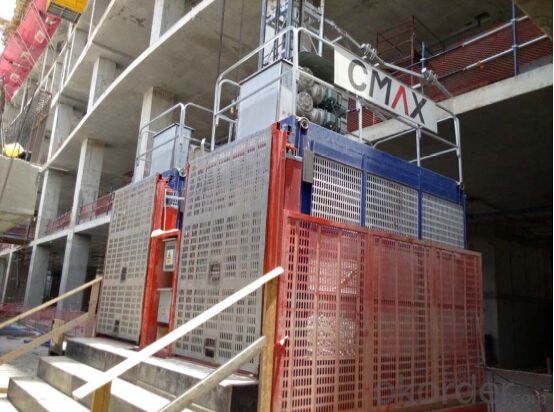
Anchorage System

Mast Section

Driving Unit

Building Hoist Specifiction
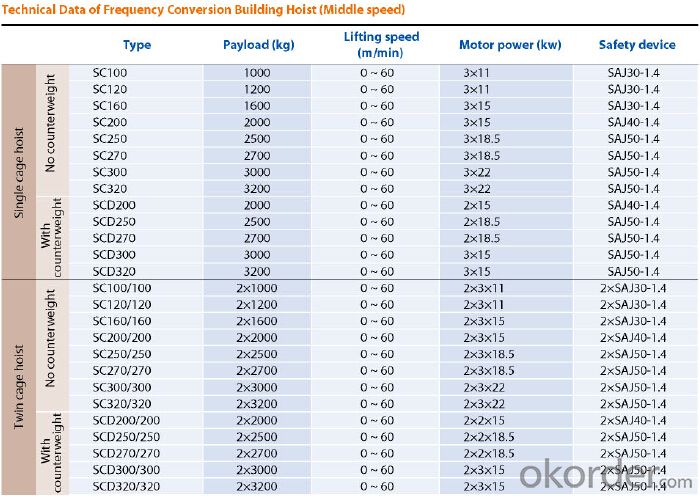
FAQ of Building Hoist
Q: What is the building hoist main purpose?
A: Building hoist equipped with double or single cabin to transport the materials and labors up and down. It's the ideal
construction equipment for vertical transportation in the field of construction.
Q: What is the main structure of building hoist?
A: The P/M construction hoist mainly contains metal structure, driving system, electrical control system, cable guide &
protection system, electrical top crane and safety device.
Q: What is the meaning of the building hoist’s code?
A: Take SC200/200 for example: “SC” stands for rack and pinion hoist, “200/200” stands for double cage and capacity
is 2 tons per cage. “SC200” stands for single cage and capacity is 2 tons.
Q: What is the dimension of the cage?
A: Normally the cage dimension is 3X1.5X2.5M (L/W/H) for 2t type hoist. Details should be checked according to our
quotation sheet. Also, the size can be customized according to the factual site condition. There are two doors (entrance
& exit doors) for each cage, It can be produced as up & down sliding or ramping model for safety and convenience.
- Q: Is it safe to use a building hoist for lifting heavy objects when there is wind?
- <p>Using a building hoist in windy weather is generally not recommended due to the increased risk of accidents. Wind can cause the hoist to sway, potentially leading to loss of control and dropping of the load. Safety guidelines typically advise against hoisting operations when wind speeds exceed certain limits, often around 20-30 miles per hour (32-48 kilometers per hour). It's crucial to check local regulations and the manufacturer's guidelines for the specific hoist model to determine safe operating conditions. Always prioritize safety and ensure that all necessary precautions are taken to secure the load and the hoist in windy conditions.</p>
- Q: This question asks for measures to protect lifting equipment from damage during its operation.
- <p>To prevent damage to lifting equipment during operation, ensure regular maintenance and inspection are conducted to check for wear and tear. Adhere to the equipment's load limits and never exceed them. Use appropriate lifting techniques and ensure the load is balanced. Keep the equipment clean and free from debris. Train operators thoroughly on safe operating procedures. Avoid sudden starts or stops, and ensure all safety features and guards are in place and functioning correctly. Regularly check cables, hooks, and other critical components for any signs of damage. Always follow the manufacturer's guidelines and industry safety standards.</p>
- Q: This question asks for a description of the process of using an emergency stop button specifically in the context of a building hoist.
- <p>To use an emergency stop button on a building hoist, first, ensure you are familiar with the hoist's controls and safety features. Locate the emergency stop button, which is typically a red mushroom-shaped button or switch, prominently placed and easily accessible. In an emergency, press and hold the button firmly. This action will immediately stop all hoist functions, including movement and operation. After pressing the emergency stop, evacuate the area if necessary and notify the appropriate personnel to address the situation. Remember, the emergency stop should only be used in situations where immediate action is required to prevent harm or damage. Regular training and drills can help ensure you are prepared to use the emergency stop button correctly and effectively.</p>
- Q: This question asks about the various elements that can influence the efficiency and effectiveness of a building hoist.
- <p>The performance of a building hoist is affected by several factors including the type and weight of materials being lifted, the frequency of use, the hoist's mechanical condition and maintenance, environmental conditions such as wind and temperature, the skill and training of operators, and the design and capacity of the hoist itself. Proper installation, regular inspections, and adherence to safety protocols also play a crucial role in ensuring optimal performance and safety. Additionally, the quality of electrical systems, the efficiency of the drive mechanism, and the structural integrity of the hoist's components can significantly impact its operation.</p>
- Q: This question asks for an explanation of the different types of building hoists used in construction.
- <p>Building hoists, also known as construction hoists or material hoists, are essential for moving materials and personnel in high-rise construction projects. The main types include: 1. <strong>Freestanding Hoists</strong>: These do not require a building structure for support and are self-supporting. 2. <strong>Cladding Hoists</strong>: Attached to the building's facade, used for moving materials during cladding work. 3. <strong>Personnel Hoists</strong>: Specifically designed for transporting workers, ensuring safety with features like cages and safety devices. 4. <strong>Material Hoists</strong>: Built to transport heavy construction materials and are robust and durable. 5. <strong>Electric Hoists</strong>: Operated by electricity, offering precise control and energy efficiency. 6. <strong>Hydraulic Hoists</strong>: Utilize hydraulic systems for lifting, known for their smooth operation and heavy load capacity. Each type serves a specific purpose and is chosen based on the project's requirements and the stage of construction.</p>
- Q: This question asks for the safety precautions that should be taken when operating electric-hydraulic construction hoists.
- <p>Safety measures for using electric-hydraulic building hoists include regular maintenance and inspection to ensure all components are in good working order. Operators must be trained and certified, following all safety protocols. Never exceed the hoist's load capacity. Ensure that safety hooks and chains are in place and secure. Keep the hoist area clear of debris and unauthorized personnel. Use proper lifting techniques and avoid sudden starts or stops. Always inspect the load before lifting to ensure it is stable and secure. Emergency stop switches should be easily accessible. Ensure that all safety guards are in place and functioning properly. Adhere to all local regulations and manufacturer's guidelines.</p>
- Q: Is it possible to use a building hoist for lifting heavy materials that cannot be manually lifted?
- <p>Yes, a building hoist is specifically designed for lifting heavy materials that are too heavy or cumbersome to lift manually. These hoists are engineered to handle significant weight loads and are commonly used in construction settings to move materials such as bricks, cement, and steel beams to various levels of a building. They are an essential tool for safe and efficient material handling in construction projects.</p>
- Q: Is it possible to utilize a double-rope lifting mechanism within the context of a building hoist?
- <p>Yes, a double-rope lifting system can be used in a building hoist. This system offers advantages such as increased safety due to redundancy and the ability to lift heavier loads compared to a single-rope system. The double-rope setup allows for the hoist to handle the load with two separate ropes, reducing the risk of failure and providing a more stable lifting platform. It's common in applications where high load capacities and safety are paramount, such as in construction for lifting materials and equipment.</p>
- Q: This question asks if it is permissible to use a building hoist for the purpose of lifting people.
- <p>No, a building hoist should not be used for lifting people. Building hoists are designed for the transportation of materials and equipment during construction, not for carrying personnel. Using a building hoist to lift people is dangerous and against safety regulations. It poses significant risks, including falls and equipment malfunctions, which can lead to serious injuries or fatalities. Always use designated personnel lifts or other safe methods for moving people in construction settings.</p>
- Q: Is it possible to utilize a building hoist for the transportation of heavy objects?
- <p>Yes, a building hoist is specifically designed to move heavy objects within a construction site or in similar environments. It is a type of crane that can lift and lower materials vertically, making it ideal for transporting heavy items such as construction materials, machinery, and equipment. Building hoists are engineered to handle significant weight loads and are an essential tool for efficient material movement in vertical construction projects.</p>
Send your message to us
Building Hoist SCD200 with Stepless Speed Control Helps Eliminate the Concussion
- Loading Port:
- China main port
- Payment Terms:
- TT or LC
- Min Order Qty:
- 1 unit
- Supply Capability:
- 30 unit/month
OKorder Service Pledge
OKorder Financial Service
Similar products
Hot products
Hot Searches
Related keywords







